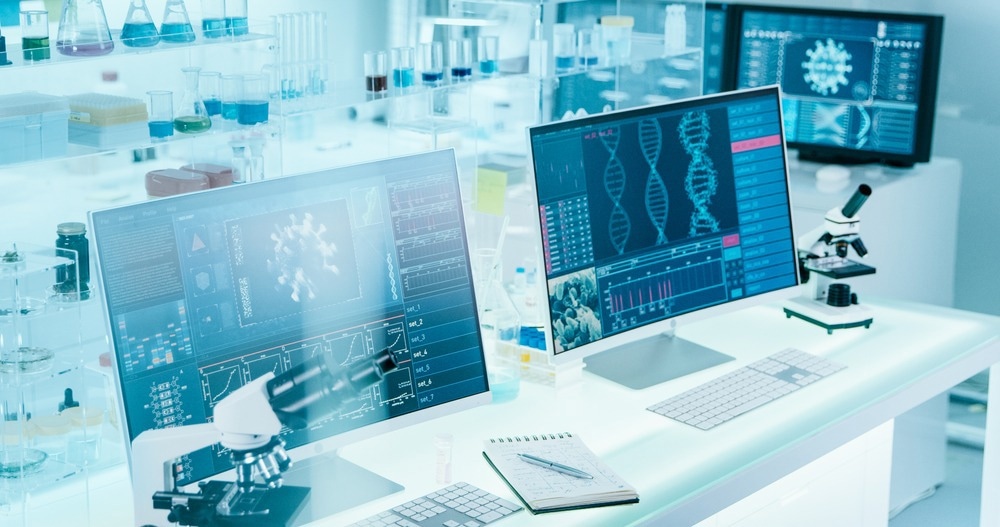Writing in the journal Nature Scientific Reports, a team of scientists from China and South Korea has reported the development of a microwave microfluidic microsensor for blood glucose monitoring.

Study: Microfluidic microwave biosensor based on biomimetic materials for the quantitative detection of glucose. Image Credit: Marcin Janiec/Shutterstock.com
Diabetes: A Major Public Health Issue
Diabetes is a major health issue that is predicted to affect 783.2 million people worldwide by 2045, according to research by the International Diabetes Foundation. Diabetes occurs when the body cannot efficiently regulate blood glucose, with either too much or too little produced.
This condition can lead to secondary complications such as renal failure, blindness, cerebrovascular and cardiovascular disease, and, in extreme cases, can be fatal. Diabetes causes an immense burden on national healthcare infrastructure, costing vast amounts of money for governments. According to a 2014 report by diabetes.org.uk, in the UK alone 11% of total inpatient costs are associated with caring for diabetic patients.
Monitoring Blood Glucose Levels in Diabetic Patients
Monitoring the blood glucose levels of diabetic patients is vital for ensuring favorable treatment outcomes. Several self-monitoring methods have been developed in recent years which help patients manage their condition. The conventional method which is widely available today involves drawing blood from a patient’s fingertips and using a single-use test strip.
However, this technique has a few drawbacks. It causes physical discomfort for patients and is invasive. Moreover, single-use test strips cause environmental issues due to the need to dispose of them after use. Because of their contamination with bodily fluids, namely blood, they cannot be recycled properly.
There is, therefore, an urgent need for non-invasive, cost-effective, high-precision, and stable blood glucose monitoring technologies. Several alternative real-time monitoring strategies have been explored in recent studies based on different technologies.
Proposed methods include optical, electrochemical, and microwave techniques. Near-infrared optical methods and reverse iontophoresis methods have been explored, but these techniques have some limitations. In the case of near-infrared methods, water content in biological tissues affects the strength of light attenuation. Reverse iontophoresis methods are limited by short lifespans and precision degradation over time.
Microwave-based techniques possess the benefits of low cost, simple design, facile fabrication, rapid detection speed, and high sensitivity. Recent research has demonstrated the integration of microfluidic devices with microwave technologies to further enhance the accuracy and sensitivity of biological sample detection.
However, there are still some challenges with microfluidic microwave microsensors, which must be addressed before they can be widely employed for rapid, real-time blood glucose self-monitoring applications. Recent research has produced devices from materials such as PDMS and Teflon capillaries, with low sensitivity and high detection limits proving challenging. Biomimetic devices could further improve the performance of microfluidic sensors.
The Study
The paper has reported the development of a biomimetic microfluidic device for blood glucose detection with an integrated microwave sensor. The main benefit of using biomimetic devices is that they can accurately simulate tissue- and organ-level physiological functions in vitro.
Structurally, the sensor incorporates a microstrip patch antenna which possesses defective ground structures. These structures increase the inductance and capacitance of the sensor’s transmission line.
A glucose solution sample was used to evaluate the effectiveness of the proposed sensor. The dielectric properties of different glucose concentrations are distinct and require modification to the reflection coefficient and resonant frequency of the sensors.
The authors optimized the proposed sensor’s resonant frequency to calculate its detection limit and sensitivity. Furthermore, by optimizing this parameter, the authors analyzed and categorized the sensor’s response time and stability.
Study Findings
The sensor was evaluated on different glucose concentrations from 50-500 mg/dL. Experimental results indicated that the use of the microfluidic device reduced errors. The correlation between glucose concentration, reflection coefficient, and resonant frequency of the sensor was enhanced.
By optimizing the sensor, low detection limits (7.7 mg/dL) and a high sensitivity (0.23 MHz/(mg/dL)) were achieved in the proposed system. The stability of the sensor was excellent, and a rapid response time of ~ 150 ms was observed. Correlation coefficients of the sensor’s reflection coefficient and resonant frequency with respective glucose concentrations of 0.996 and 0.984 were achieved.
In Summary
The paper has demonstrated the suitability of this novel microwave microfluidic microsensor for blood glucose level detection. It can accurately differentiate between different glucose solution concentrations with high sensitivity, low detection limits, excellent stability, and a rapid response time. The proposed sensor can be used for real-time, non-invasive blood glucose monitoring and, moreover, is suitable for early-stage detection, improving the quality of life for diabetes patients.
More from AZoM: A Review of Modern Wastewater Treatment Methods
Further Reading
Zhang, M et al. (2022) Microfluidic microwave biosensor based on biomimetic materials for the quantitative detection of glucose Nature Scientific Reports 12: 15961 [online] nature.com. Available at: https://doi.org/10.1038/s41598-022-20285-6.
Disclaimer: The views expressed here are those of the author expressed in their private capacity and do not necessarily represent the views of AZoM.com Limited T/A AZoNetwork the owner and operator of this website. This disclaimer forms part of the Terms and conditions of use of this website.